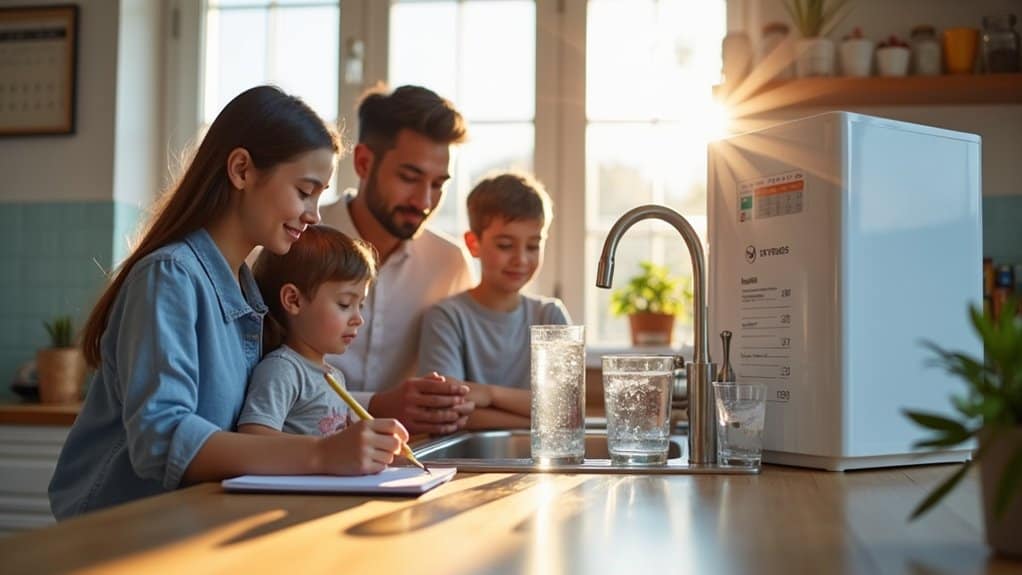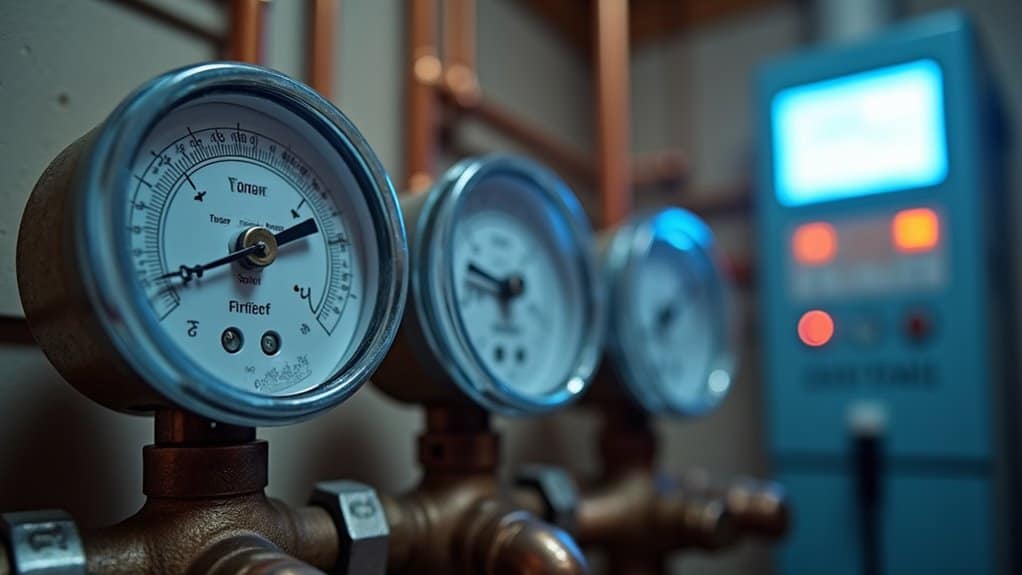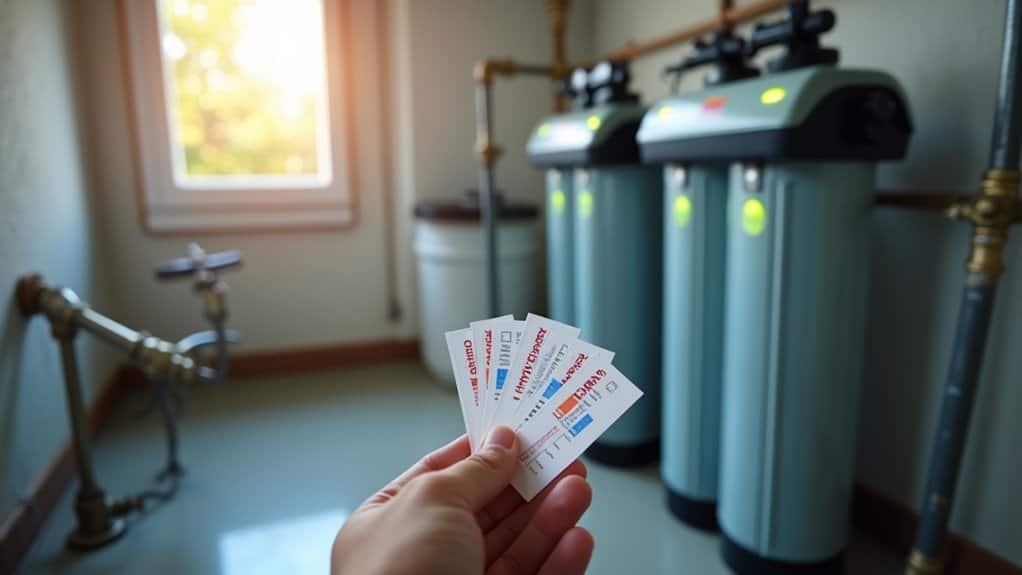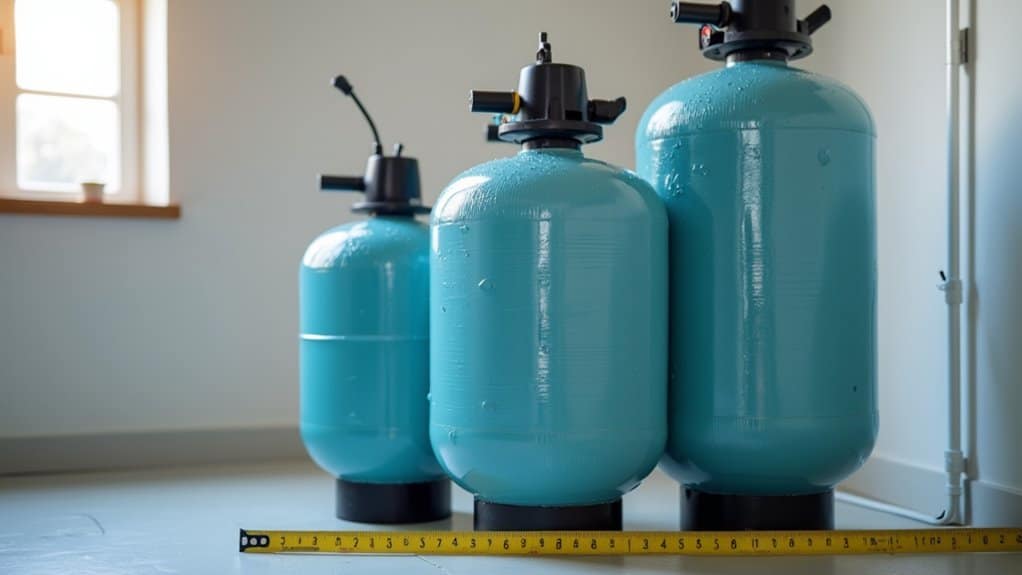The “Goldilocks” method for water softener sizing means finding a system that’s neither too large nor too small for your needs. We calculate the perfect size by multiplying your daily water usage (gallons) by your water hardness level (grains per gallon), then multiplying by 7 for weekly regeneration. A properly sized system balances efficient hardness removal with minimal salt and water waste. Our sizing guide below reveals the exact calculations for your household’s perfect fit.
Key Takeaways
- The Goldilocks Method seeks the ideal water softener size that’s neither too large (wasteful) nor too small (inefficient).
- Calculate your daily water usage by multiplying household members by 75 gallons for accurate capacity needs.
- Determine your exact water hardness level using test kits to properly size your system.
- Size your system for weekly regeneration by multiplying daily grain removal needs by seven.
- Balance flow rate requirements (8-12 GPM for average homes) with your household’s peak water demand period.
Understanding Your Household Water Hardness Levels

Why does water hardness matter when selecting a water softener? It’s the most critical factor in determining the size and capacity you’ll need.
Water hardness is measured in grains per gallon (GPG) or parts per million (ppm), with classifications ranging from soft (<3.5 GPG) to very hard (>14.5 GPG).
You can determine your water’s hardness through home test kits, professional lab analysis, utility reports, or digital meters like AquaVeritas. In Central Indiana, residents typically experience moderately hard to hard water levels between 121-250 ppm.
The impacts escalate with hardness levels—from minimal scaling at <3.5 GPG to extensive appliance damage and skin dryness at >14.5 GPG.
Calculating Your Family’s Daily Water Consumption Needs

Accurately calculating your daily water consumption is the second critical factor in selecting an appropriately sized water softener system. Most households use between 50-100 gallons per person daily for indoor activities.
For quick estimation, multiply the number of residents by 75 gallons. A family of four typically consumes 200-400 gallons daily or approximately 12,000 gallons monthly. Household size can significantly influence the ideal capacity of your water softener system.
Your specific usage depends on several variables:
- Household composition (teenagers use more water)
- Appliance efficiency (front-loading washers use less)
- Fixture types (low-flow toilets: 1.6 gallons/flush vs. standard: 5 gallons)
- Bathing habits (showers: 5 gallons/minute; baths: 42 gallons)
When designing your water system, remember that it’s recommended to size it to provide your entire daily water use within a 2-hour peak demand period.
Determining Optimal Flow Rates for Your Home

Determining the optimal flow rate stands as the third critical factor when selecting a water softener that meets your home’s specific needs.
Most average households require 8-12 GPM, while larger homes may need up to 15 GPM to handle peak usage periods when multiple fixtures operate simultaneously. A well-sized softener can significantly enhance your home’s overall water quality.
The system type directly impacts flow dynamics—dual-tank systems prevent pressure drops during regeneration, while salt-free filters may restrict flow.
For optimal performance, your softener should process 3-15 GPM per square foot of resin bed area, with pipe diameter and installation proximity to the main supply significantly affecting pressure maintenance. Accurately measuring your household’s water usage calculation helps ensure you select a properly sized system that won’t compromise water pressure during peak demand times.
Balancing Capacity With Efficiency: the Right-Sized System

Balancing system capacity with operational efficiency represents the cornerstone of selecting an appropriately sized water softener for your home.
We calculate your needed capacity by determining daily grain removal (gallons used × grains per gallon hardness), then multiplying by seven for weekly regeneration cycles. This careful calculation ensures you achieve significant cost savings by avoiding common sizing mistakes.
For most households (1-4 people), a 30,000-grain system typically suffices.
Going too large wastes salt and water during regeneration, while undersized units regenerate too frequently, reducing efficiency and lifespan.
The perfect balance—your “Goldilocks” system—meets your household’s hardness removal needs while minimizing operational costs through optimal regeneration frequency. Optimizing salt dosage is crucial as lower doses yield higher brine efficiency but may impact water efficiency and iron removal capabilities.
Frequently Asked Questions
How Often Should I Regenerate My Water Softener?
We typically regenerate water softeners every 2-3 days, but factors like water hardness, usage volume, resin capacity, and system type determine your optimal cycle frequency. Check your system’s specifications.
Can I Install a Water Softener Myself?
Yes, we can install water softeners ourselves if we’re comfortable with basic plumbing. We’ll need proper tools, pressure between 20-125 psi, and should follow manufacturer guidelines for warranty protection.
Will Softened Water Affect My Plants or Garden?
Yes, softened water can harm plants. Sodium replaces calcium in soil, degrades structure, and disrupts water balance. We recommend using bypasses, dedicated outdoor taps, or mixing with rainwater when irrigating gardens.
How Long Do Water Softeners Typically Last?
We typically see water softeners lasting 10-15 years with proper maintenance. Salt-free systems can exceed 20 years, while salt-based units average 15 years before efficiency declines, requiring eventual replacement.
Do Water Softeners Work With Well Water Systems?
Yes, water softeners work exceptionally well with well water systems. We’ve engineered them specifically to address the high mineral content and contaminants typically found in groundwater supplies.
Conclusion
We’ve explored the critical factors in water softener sizing: hardness levels, daily consumption, flow rates, and capacity-efficiency balance. By following our “Goldilocks” approach, you’ll avoid oversized systems that waste resources or undersized units that regenerate too frequently. The ideal water softener isn’t too big or too small—it’s specifically matched to your household’s unique water profile and usage patterns.

Craig “The Water Guy” Phillips is the founder of Quality Water Treatment (QWT) and creator of SoftPro Water Systems.
With over 30 years of experience, Craig has transformed the water treatment industry through his commitment to honest solutions, innovative technology, and customer education.
Known for rejecting high-pressure sales tactics in favor of a consultative approach, Craig leads a family-owned business that serves thousands of households nationwide.
Craig continues to drive innovation in water treatment while maintaining his mission of “transforming water for the betterment of humanity” through transparent pricing, comprehensive customer support, and genuine expertise.
When not developing new water treatment solutions, Craig creates educational content to help homeowners make informed decisions about their water quality.


